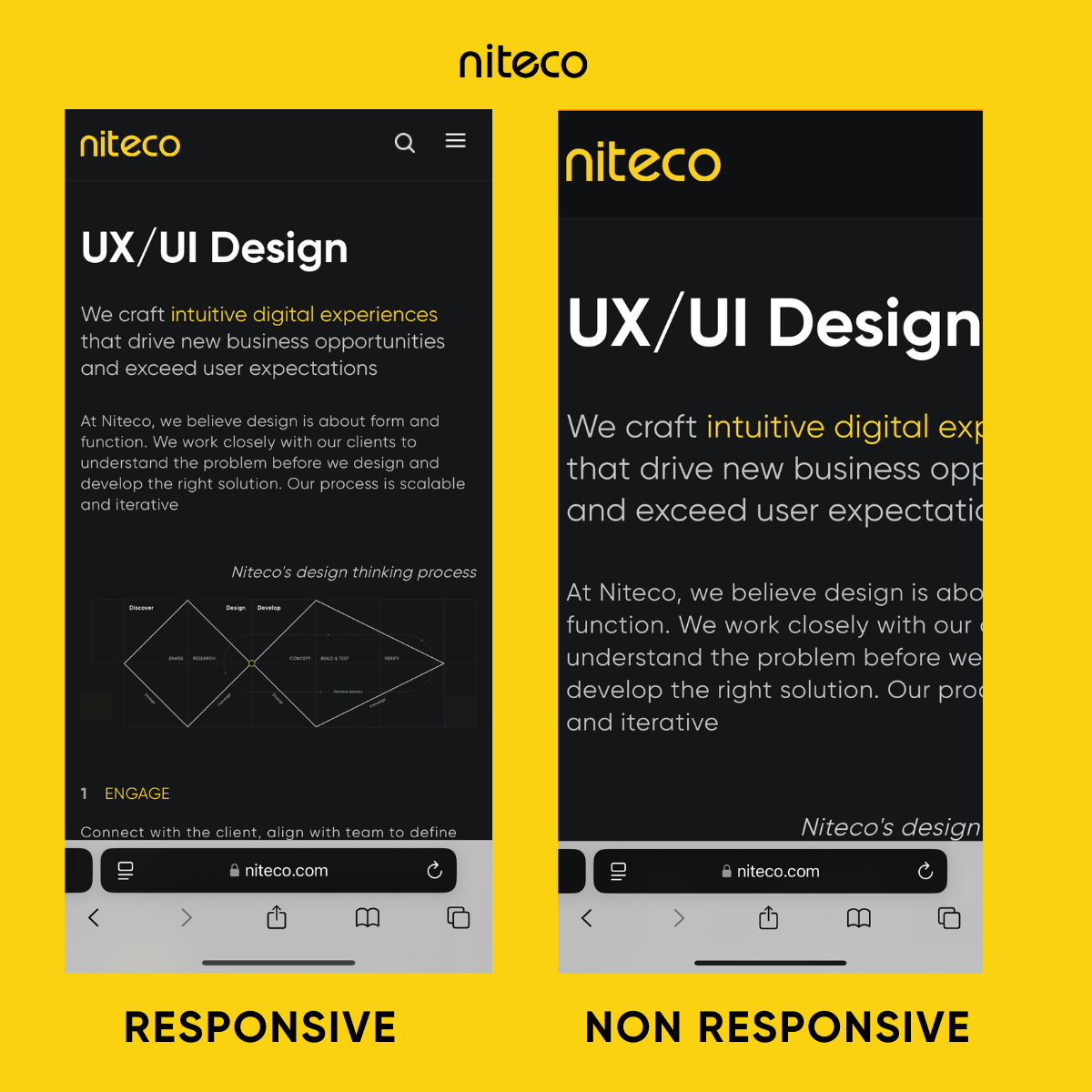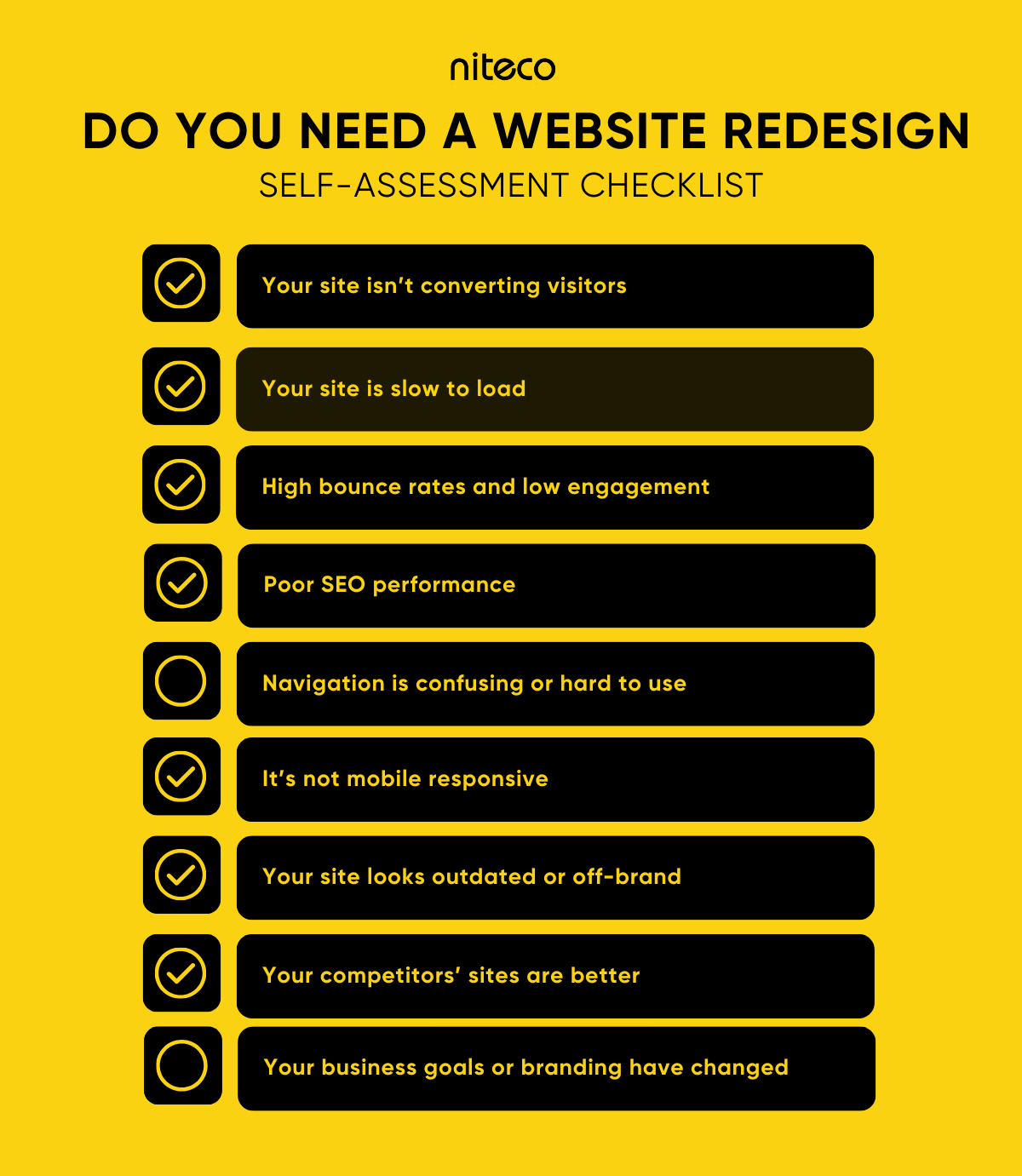An underperforming website can damage your business - slowing down user experience, limiting your search visibility, and hurting conversions. Often, these issues aren’t just minor bugs or outdated content - they’re signs that your site no longer meets the needs of your users or your business.
That’s where a strategic website redesign comes in. Far from just a visual refresh, a redesign can dramatically improve speed, usability, SEO, and security. In fact, 75% of users judge a company’s credibility based on its website design, and 38% will stop engaging if the content or layout feels outdated.
Redesigning your website helps realign it with your business goals, deliver a smoother user journey, and meet the expectations of today’s digital audience. So, when is it time to redesign your website? In this article, we interviewed Chieu Phung, Niteco’s UX/UI Design Lead, to break down 9 clear signs your site might be holding your business back and how a redesign can turn that around.
Top 9 signs your website needs a redesign
At Niteco, we’ve spent over 15 years helping global brands transform their digital presence through strategic website redesigns. With that much hands-on experience, we know exactly when a website is due for a redesign - and the impact a well-executed one can have.
There's a case, our client, Vintec, Electrolux’s premium wine storage brand, realized their site wasn’t keeping up with their growth goals, they partnered with us to launch a modern, high-performing platform. The result? A 98/100 Lighthouse performance score, a 10.7% increase in “Buy Online” clicks, and a site ready for scalable expansion across APAC.
So, how can you tell if it’s time to revamp your own website? Let’s start with the first sign.
Revenue and growth warning signs
1. Your site isn’t converting visitors
A crucial sign answering “when is it time to redesign your website" is a low conversion rate. If visitors aren't taking desired actions like filling out forms or making purchases, despite steady traffic, your site isn't effectively supporting your lead generation and sales. This often points to issues like unclear calls to action, cluttered design, or slow loading speeds, making a website redesign essential for improving performance.
How a redesign helps: A conversion-focused redesign can streamline your content, sharpen your messaging, and optimize user flows so that visitors are guided to take action. It can also help you better align your website with your sales funnel, making every click count.
2. Your site is slow to load
Most users won’t stick around if your site takes more than a few seconds to load. With broadband and mobile networks speeding up, expectations for instant access are now the norm. Page load time is a major factor in bounce rates and search rankings. Google uses site speed as a ranking signal, and users who have to wait more than three seconds will likely move on to a competitor’s site (Magebit, 2024). Learn why your website might be slow and how to fix it.
How a redesign helps: Redesigning your site allows you to optimize large images and scripts, eliminate unnecessary code, adopt lighter frameworks, and leverage modern hosting solutions that improve performance. The result is a faster, more responsive site that keeps users engaged.
3. High bounce rates and low engagement
When users leave your site within seconds or don’t interact with your content, it often means they didn’t find what they expected or weren’t motivated to explore further. This disconnect between user intent and site experience can hurt SEO, waste valuable traffic, and signal broader UX issues.
How a redesign helps: A redesigned website can improve user engagement through better content structure, visual hierarchy, and a layout that makes it easier to absorb information and navigate naturally. When pages are clean, focused, and visually appealing, users stick around and that creates more opportunities for conversion.
Technical and SEO warning signs
4. Poor SEO performance
If your website isn’t ranking - or worse, not showing up at all - for key search terms, the issue often goes beyond missing keywords. And recently leaked internal documentation confirms that Google tracks factors like site quality, structure, and user interaction to shape rankings, meaning a poorly built, slow, or outdated site sends negative signals to search engines, making it harder for potential customers to find you.
How a redesign helps: A website redesign allows you to rebuild with SEO best practices from the ground up. That includes cleaner architecture, mobile-first design, faster performance, and streamlined navigation - all optimized for both users and search engines. With the right strategy, your content becomes easier to discover, more engaging, and better aligned with how modern SEO actually works.
5. Navigation is confusing or hard to use
When site navigation is unclear due to cluttered menus, inconsistent labels, or too many clicks to reach key content, users quickly get frustrated and leave. Effective navigation is critical for guiding visitors, reducing bounce rates, and supporting conversions. It also plays a key role in SEO, as search engines rely on clear site structure to properly index your pages.
How redesign helps: A redesign lets you rethink how your site is organized. Good navigation should be intuitive, predictable, and help users reach their goals without friction. You can simplify menus, group content more logically, and make key actions easier to access. It also gives you the opportunity to apply consistent labels, reduce clicks, and add helpful visual cues, making the whole experience smoother and more enjoyable for users.
6. It’s not mobile responsive
If your site requires users to pinch, zoom, or struggle with buttons on their phone, it’s not truly mobile-friendly. With over 63% of website traffic coming from mobile devices in 2025 (Explodingtopics), a poor mobile experience leads to higher bounce rates and fewer conversions. Google also prioritizes mobile usability in its rankings, so if your site isn’t responsive, both your users and your visibility will suffer.

How a redesign helps: A mobile-first redesign ensures your website looks and functions great on all screen sizes. It means layouts that adjust automatically, buttons that are easy to tap, and text that’s easy to read. The result is a faster, cleaner, and more user-friendly experience that benefits both your visitors and your SEO rankings.
To understand how mobile-first design improves usability and performance, read our guide on mobile-first design and how to implement it effectively.
Business and strategic warning signs
7. Your site looks outdated or off-brand
If your website feels visually dated or no longer reflects your current brand identity, it might be doing more damage than you realize. This could include outdated fonts, old logos, inconsistent colors, or messaging that no longer aligns with your business today. A dated or off-brand website can create a sense of distrust or disinterest. If your site doesn’t look polished and professional, potential customers may assume your services aren’t either.
How redesign helps: A redesign allows you to modernize your look and feel while reinforcing your current brand. That includes updating your logo, color palette, typography, and tone of voice. With a cohesive, on-brand experience, your website can better represent your business and build immediate trust with visitors.
8. Your competitors' sites are better
In a competitive market, buyers compare options quickly and often judge credibility based on the quality of your website. Even small differences in speed, clarity, or structure can sway users toward a competitor’s site.
With Niteco's Performance Insight Tool, you can run performance reports on your competitors' websites and directly compare how your pages load against theirs. This helps you identify exactly where they’re outperforming you and where you have the advantage.
How redesign helps: A redesign gives you the opportunity to study your competitors and identify what they’re doing better. From there, you can improve your website, such as enhancing your design, streamlining your user journey, adding features your audience expects, and positioning your brand as the leader in your space.
9. Your business goals or messaging have changed
When your business growth but your website doesn’t, the disconnect becomes obvious. Outdated messaging, irrelevant services, or content that no longer speaks to your audience can confuse visitors and dilute your brand. If your site doesn’t clearly reflect who you are today, it’s likely costing you trust and conversions.
How redesign helps: A website redesign gives you a fresh opportunity to align your site with where your business is now. You can revisit your goals, clarify your positioning, and ensure your messaging, visuals, and content all align with your present business strategy.
Now that we’ve covered the top 9 signs that your website may need a redesign, here’s a quick self-assessment checklist to help you evaluate where your current site stands.

If you checked more than two, it’s probably time to redesign your website.
How often should you redesign your website?
The right timing depends on what’s happening inside and outside your business. Insights from HubSpot show that marketers in fast-moving industries like tech and Commerce often update their websites every 18 to 24 months to stay competitive. On the other hand, businesses in more stable sectors may be able to go longer between updates if their site continues to perform well.
If your industry is evolving quickly, new technologies are reshaping user behavior, or your brand has taken a new direction, your website needs to keep pace. These shifts all impact how effective your current site is at supporting growth and engagement. To see how strong design choices improve performance, discover the benefits of good UX/UI design here.
Conclusion: Transform your digital experience with the right partner
At Niteco, backed by our expertise in experience design and application development, we deliver solutions that are both visually compelling and technically sound. Our UX/UI process is user-centered, scalable, and aligned with real business outcomes.
Find out how Niteco can help you turn your website that works harder, looks better, and delivers more.
FAQs
A website redesign typically takes anywhere from a few weeks to several months, depending on the size, complexity, and specific needs of the project.
Yes. With proper SEO planning like URL redirects, metadata retention, and clean site structure, you can preserve or even improve your rankings.
A refresh updates visuals and content, while a complete website redesign rethinks structure, UX, and strategy entirely.
No. Your current site stays live while the new version is built, with minimal downtime during launch.
